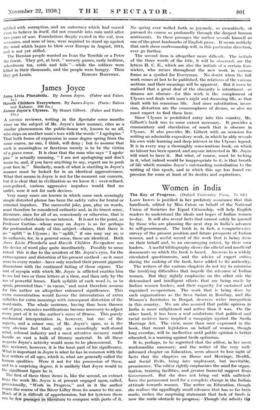Women in India
The Key of Progress. (Oxford University Press, 7s. ed.) LADY lawns is justified in her prefatory assurance that this handbook, edited by Miss Caton on behalf of the National Union of Societies for Equal Citizenship, will help English readers to understand the ideals and hopes of Indian women to-day. It will also reveal facts that cannot safely be ignored by those who are planning the next step in India's advance to self-government. The book is, in fact, a comprehensive survey of the present position and future prospects of Indian women, and a useful record of the work that is being done on their behalf and, to an encouraging extent, by their own leaders. A useful bibliography shows the official and unofficial documents on which the book is based. Answers to a widely circulated questionnaire, and the advice of expert critics during the making of the book, have added to its authority.
The writers of the various chapters do not try to minimise the terrifying difficulties that impede the advance of Indiair women. But they rightly emphasize on the other side the determined and intelligent efforts that are being made by Indian women leaders, and their capacity for sustained and organized co-operation. The work that is being done by such organisations as the Soya Sadan in Bombay, and the Women's Institutes in Bengal, deserves wider recognition in this country. We are also assured that public opinion in India is more enlightened and active than it was. On the other hand, it has been a real misfortune that political and racial motives have inspired a campaign against the Sarcht Marriage Act. The view, more than once expressed in the book, that recent legislation on behalf of women, though long overdue, will be ineffective until public opinion is better educated, is a warning against facile optimism.
It is, perhaps, to be regretted that the editor, in her most workmanlike summary, and the writer of the very weffl informed chapter on Education, seem almost to lose sight. of facts that the chapters on Home and Marriage, Heititll, and Social Evils, bring into unpleasant, but inevitib14, prominence. The editor rightly emphasiies the need for organ. ization, training. facilities, and greater financial support fr041 Government. But she does not bring out with sufficient force the paramount need for a complete change in the Ind* attitude towards women. The writer on Education, thaugh she realises the appallingly small advance that has so far beep made, makes the surprising statement that lack of funds is now- the main obstaele to-progress?-,s'pheiugh7She admits tit/ blighting influence of apathy and early marriage, she believes that propaganda and the Sarda Act are making them less formidable than poverty. This optimism is not, apparently, shared by all her colleagues. It is, perhaps, responsible for the somewhat inadequate attention paid to the work of Christian missions. It is essentially to the Indian Christian community that one is compelled to look for women who will devote their lives to teaching and preparation for it. And there are some who doubt whether the ideas that, interwoven into the fabric of Indian life, impede the advance of women will ever yield to any conception of life that has not a religious sanction stronger than that which solidifies Indian life at present.
Miss Caton's chapter on Women in Public Life tells us what we ought to know about the All-India Women's Edue. ational and Social Conference. She- reminds us also that women can be members of the Legislative-Assembly and of all provincial legislatures except two. Though outside Madras less than 1 per cent. of the adult female population is en- franchised, there are nominated women members in several Provincial Councils, and one of these has risen to the post of Deputy President. From the chapter on Industrial Life we gather that in Bombay at least philanthropic bodies are training women inspectors and social welfare workers to help their sisters in a sphere where they are peculiarly helpless. Even for their rural life there are the beginnings of welfare work in the Village Uplift' Movement spreading outwards from Gurgaon in the Punjab, and in the Women's Institutes of Bengal.
Advance depends, of course, on better organisation and more funds. But primarily what is wanted is a new attitude towards women in Indian society as a whole. From a change of heart the rest would follow. A change in the heart of India can be produced only by personality fired by a great ideal. Whether anything but religion can supply the motive power which the realization of all ideals requires is a question that this handbook does not try to answer. But it is one of its many useful features that the facts which it sets forth so clearly make the question inevitable. ARTHUR MAYHEW.



















































































 Previous page
Previous page